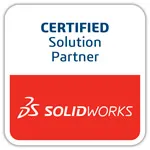Take Your Skills to a New Level!
The SolidWorks 2020: Advanced Parts & Assemblies course shows you how to unlock the power of custom configurations, use equations to create features, work with design tables, create part generators and much much more. This course is packed with tips and tricks that will make your models and assemblies bulletproof.
So the title of the course describes what you'll learn. You'll learn advanced methods of creating single part models, and you'll learn basic through advanced methods of creating and working with assemblies. You'll also learn that you can merge the two concepts together by creating assemblies from single part models. In fact, this is called multi-body modeling or top down design. There are too many facets of this concept to discuss here, but you can be assured to learn all about it in the course.
The goal of this course is to teach sound practices that assure you or anyone on your team can quickly and easily edit your work. Sound practice and procedures also help prevent the need to scrap work and start over. Too often users find themselves having to scrap a model because it has become unmanageable. It falls apart when you try to edit it, and this consumes a great deal of your time. This and all our courses focus on workflows that minimize or remove the need to scrap your work. This can save you a great deal of time and money.
The SOLIDWORKS 2020: Advanced Parts & Assemblies course has over 7.9 hours of video instruction. If you study the course 8 hours a day, the average time it takes to watch the lessons and practice the tasks is about 3 days. When you're finished you'll have an extremely strong foundation of skills that are required for subsequent courses.
81 Lessons (Listed Below)
7.9 hours of instruction
Browse through the lessons from the following SolidWorks 2020 courses and watch sample lessons.
SolidWorks 2020: Professional Modeling SolidWorks 2020: Advanced Parts & Assemblies SolidWorks 2020: Mechanical Drawings SolidWorks 2020: Sheet Metal Design SolidWorks 2020: FEA Made SimpleOur SolidWorks courses require No Installation. You can watch them on any device connected to the internet.
You will receive an email containing your User Name and Password. Login to your account and start learning. It's that easy.
While you're logged into your account you can download files used in the courses, watch lessons, and practice the tasks taught in the lessons. Keep in mind that you will use your installation of SolidWorks® to practice.
Get your SolidWorks® 2020 training now. You can start learning in minutes.
SolidWorks® 2020:
Advanced Parts & Assemblies
No Installation Required
Watch from any device connected to the internet.

$54.95 - $109.95
Watch Sample Lessons
Watch the first hour of the Professional Modeling course for SolidWorks 2020.
 Click to Watch!
Click to Watch!Advanced Parts & Assemblies
7.9 hours of instruction
Lessons
Introduction
Files and Folders
Custom Materials
Mastering Materials
Custom Color Swatches
Intro to Custom Appearances
Creating Helixes
Helical Threads
Limits to Reusing Sketches
RealView and Scene Display
Introduction to Configurations
Add Configurations
Machined Versions
Comparing Configurations
Configuration Parameters
Material Configurations
Setting Surface Materials
Updating Template Configurations
Derived Configurations
Cast Configurations
Machined Configurations
Parent Child Configurations
Derived Material Settings
Introduction to Design Tables
Design Table Parameters
Parameter Syntax
Blank Design Tables
Select and Rename Dimensions
State Design Table Parameters
Reduce Design Table Memory I
Reduce Design Table Memory II
Importing Excel Files
Introduction to Equations
Equations and Configurations
Feature Parameter Equations
Conditional Statements
Equations and Design Parameters
Direct Input Equations
Custom Assembly Templates
Introduction to Weldments
Modifying Joints and Members
Trim Extend Members
End Caps
Gussets
Weld Preparations
Exporting Bodies to Assemblies
Fillet Weld Beads
Weld Strategies
Intermittent Welds
Custom Libraries
Custom Profiles
Using Custom Profiles
Degrees of Freedom
Understanding Mate Errors
Mate Type Errors
Mate Strategies
Width Mate
Symmetric Mate
Linear Coupler Mate
Advanced Distance Mate
Advanced Angle Mate
Organizing Assembly Components
Bottom Up Design
Linear Component Pattern
Shortcomings of Bottom Up Design
Middle Out Design
Creating Sub Assemblies
Adding the Toolbox
Building Sub Assemblies
Create Parts from Surfaces
Effective Smart Mates
Advanced Assembly Aspects
Projecting Curves to Surfaces
Cutting With Surfaces
Assemblies into Parts
Using Inserted Parts
Linked Part Files
Details of External References
Split Part Best Practices
Strategy for Multi-Body Modeling
Conclusion
